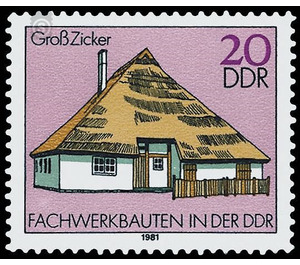Commemorative stamp series - Germany / German Democratic Republic 1981 - 20 Pfennig
Theme: Architecture
| Country | Germany / German Democratic Republic |
| Issue Date | 1981 |
| Face Value | 20.00 |
| Color | pink |
| Perforation | K 14 |
| Printing Type | Rotogravure 2 |
| Stamp Type | Postage stamp |
| Item Type | Stamp |
| Chronological Issue Number | 2366 |
| Chronological Chapter | GER-DDR |
| SID | 29263 |
| In 21 Wishlists | |
Half-timbered buildings in the GDR With the illustrations of half-timbered buildings in the GDR, the Ministry of Posts and Telecommunications of the German Democratic Republic issues six multi-colored special postage stamps. Special cancellations from July 7 to September 6, 1981 Half-timbered buildings in the GDR Many of our farmhouses are still half-timbered buildings today. By type, these go back essentially to only two basic forms, Hallhaus and Ernhaus. Of the two, the former, with its high roof over low walls, the gate in the front gable and its three-aisled hall, was originally a "unit house" with space for man, beast and crop. We meet him and his variants especially in the north of the GDR. The latter, however, often two-story, with always side doors and three-cell cross-section, is initially exclusively "Wohnstallhaus" with accommodation for farmers and livestock. We mainly meet buildings of this kind in the middle and in the south of the GDR. Developed in the early Middle Ages from simple early forms and during the economic cycle of the 16th century to full training, both types in the often small dominions of the 17th and 18th century finally won the regional variety of forms, in their artistic, historical and ethnographic statement for us today constitutes the special cultural value of the old farmhouse. 20 Pfennig value: Groß Zicker / Rügen Among the most interesting variants of the hall house are the "sugar hats" of the island of Rügen, mainly because of the late medieval relics preserved on them. Expect u. a. the "Manteltach", which often reaches deep down on all sides, as well as its always sleeper-free framework, which sometimes even lacks the bolts and knows only "cocked-on" headbands. Built shortly after 1700 Sugar Loaf in Groß Zicker is, due to its temporary special use, on Rügen also known as "Pfarrwitwenhaus".


